-

人教版新课标小学数学四年级下册数学广角教案2篇
一、初步感知间隔的含义1、请同学们伸出右手,张开,数一数,5个手指之间有几个空格?在数学上,我们把 空格叫做间隔,也就是说,5个手指之间有几个间隔?4个间隔是在几个手指之间?2. 其实,这样的数学问题,在我们的生活中,随处可见。谁能举几个这样的例子3、看图:在画面上我们看到春天桃红柳绿,到处是一派生机勃勃的景象,你们知道吗?3月12日是什么日子,这一天全国上下到处都在植树,为保护环境献出自己的一份力量。 出示图:这里从头到尾栽了几棵树,数一数,它们之间又有几个间隔呢?你发现了什么?谁来说一说?同时板书。4、那你能像这样用一个图表示出来吗?请你们选择一种动手画一画吧!5、汇报:画了8棵树,他们之间有7个间隔数,9棵树之间有8个间隔。……6、你发现植树棵树和间隔数之间有什么规律呢?(自己先想想,再把你的想法和伙伴们互相交流一下)。反馈:谁来说说你的发现?评价:哦,这是你的发现……你还能用一个算式来概括。边板书边说:同学们都发现了从头到尾栽一排树时,植树棵树比间隔数多1,(指表格),也可以写成两端要栽时,植树棵数-间隔数+1,间隔数=植树棵树-1。
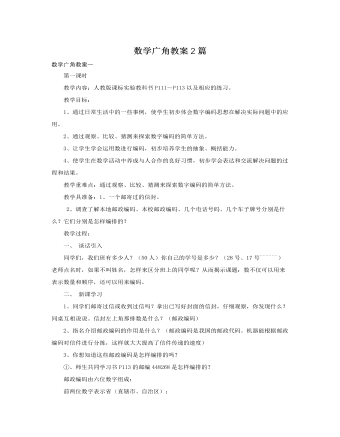
人教版新课标小学数学五年级上册数学广角教案2篇
虽然在此之前已经听过多节有关的研讨课,但临到自己教学时才真正体会到本课教学的艰难。一是信息化时代对邮政编码的冲突。其实我在教学前也仅仅只知道学校和家庭住址的邮编,至于邮政编码的结构含义等是完全陌生。在课堂前测中了解到,全班仅3人有写信寄信的经历(这三名学生的老家都远离湖北省),他们知道老家的邮编,全班有半数左右的家庭收集不到已经邮寄过的旧信封。可以说在学习本课前师生对邮政编码都是知之甚少,教师本身都只“半勺水”,何以给学生“一杯水”?虽然在课前布置学生收集了一些有关邮政编码的知识,自己也进行了大量的查询,但在实际教学中仍旧倍感吃力。如有学生质疑“为什么书上北京人民出版社的邮编是100008,它的第三、四位都是0呢”;“为什么我们学校的邮编4300XX第三、四位也是0呢”;“邮区是不是指什么市?”“邮区与市、区、县有什么关系?”一个接一个问题“炮轰”过来,着实招架不住。
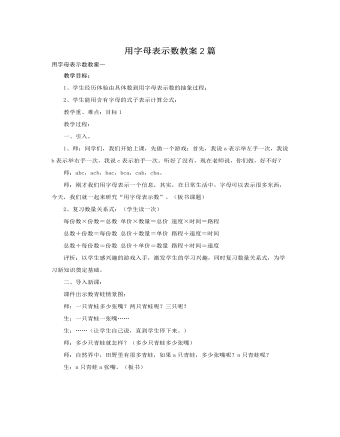
人教版新课标小学数学五年级上册用字母表示数教案2篇
教学目标:1、学生经历体验由具体数到用字母表示数的抽象过程;2、学生能用含有字母的式子表示计算公式;教学重、难点:目标1教学过程:一、引入。1、师:同学们,我们开始上课,先做一个游戏:首先,我说a表示举左手一次,我说b表示举右手一次,我说c表示拍手一次。听好了没有,现在老师说,你们做,好不好?师:abc,acb,bac,bca,cab,cba。师:刚才我们用字母表示一个信息,其实,在日常生活中,字母可以表示很多东西,今天,我们就一起来研究“用字母表示数”。(板书课题)2、复习数量关系式:(学生读一次)每份数×份数=总数 单价×数量=总价 速度×时间=路程总数÷份数=每份数 总价÷数量=单价 路程÷速度=时间总数÷每份数=份数 总价÷单价=数量 路程÷时间=速度评析:以学生感兴趣的游戏入手,激发学生的学习兴趣,同时复习数量关系式,为学习新知识奠定基础。
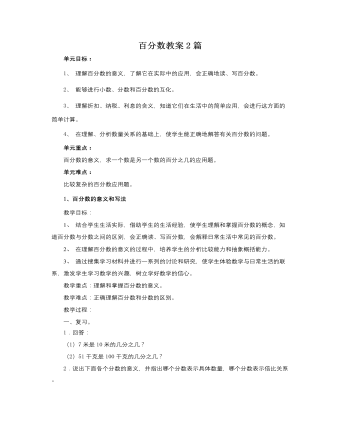
人教版新课标小学数学六年级上册百分数教案2篇
1、完成P78“做一做”第二题:读出下面的分数。2、完成P78“做一做”第一题:直接在书上的横线上写出对应的百分数。3、P79练习十九第4题:读出或写出报栏中的百分数。4、“做一做”第四题:学生根据自己的理解,说说分数和百分数在意义上有何不同。四、布置作业练习十九第1~3题。教学追记:本堂课,我从三个层次入手。第一层:联系生活实际引出百分数;第二层:理解百分数的具体含义;第三层:教学百分数的读写。三个层次,思路清晰,教学层次明显。其中,我把教学重点放在理解百分数的具体含义上,并及时与分数做了比较,教学结构较为严谨。2、百分数和分数、小数的互化教学目标:1、使学生理解并掌握百分数和小数互化的方法,能正确地把分数、小数化成百分数或把百分数化成分数、小数。2、在计算、比较,分析、探索百分数和分数、小数互化的规律的过程中,发展学生的抽象概括能力。3、通过探索百分数和分数、小数互化的规律,激发学生的数学探索意识。
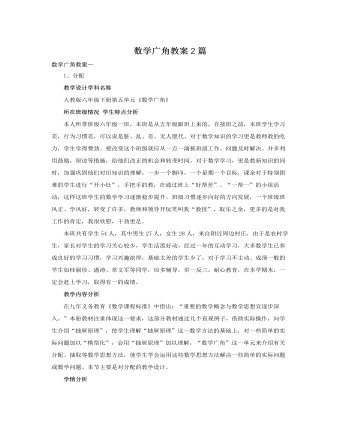
人教版新课标小学数学六年级下册数学广角教案2篇
一、创设情境,猜想验证1.猜一猜,摸一摸。一盒粉笔若干支,5种不同的颜色。至少摸几支能保证:(1)2支同色的。(2)3支同色的。(3)4支同色的。2.想一想,摸一摸。请学生独立思考后,先在小组内交流自己的想法,再动手操作试一试,验证各自的猜想。在这个过程中,教师要加强巡视,要注意引导学生思考本题与前面所讲的抽屉原理有没有联系,如果有联系,有什么样的联系,应该把什么看成抽屉,要分放的东西是什么。二、观察比较,分析推理1.说一说,在比较中初步感知。2.想一想,在反思中学习推理。三、深入探究,沟通联系四、对比练习,感悟新知1.说一说。把红、黄、蓝、白四种颜色的球各10个放到一个袋子里。至少取多少个球,可以保证取到两个颜色相同的球?2.算一算。向东小学六年级共有370名学生,其中六(2)班有49名学生。请问下面两人说的对吗?为什么?五、总结评价六、布置作业
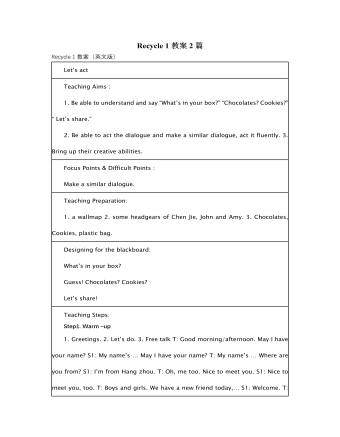
人教版新课标PEP小学英语三年级下册Recycle 1教案2篇
1.猜袋中东西数 将全班分成若干小组,每组抽一人到前面,背对着班级。教师拿一个袋子,并向学生们借一些书本,铅笔,钢笔,橡皮等,放入袋中,然后让各组学生轮流猜袋子里东西的数目,猜对的给该组记10分。 2.学生一起有节奏地说唱Let’s chant部分的歌谣,并请学生分角色表演。 (二)呈现新课 (Presentation) 1.抢读单词 教师将全班分成若干小组,然后逐个出示一些图片,学生们举手抢答,教师让最先举手的学生将图片的单词说出来,说对的给该组记10分,得分最多的组为优胜。 2.看单词卡读出单词并说出中文,复习1-3单元要求四会的单词。 3.教师用实物投影出示1-3单元课文中的某一幅图片,让学生根据图片内容进行对话练习。 4.让学生填写Assessment部分的内容,自己对1-3单元所学内容的掌握情况进行自我评价。 5.教师向学生出示已制作好的window card:This si a window card.并教读window card教师问学生:Do you like it? Can you make it? Do you want to learn how to make a window card?
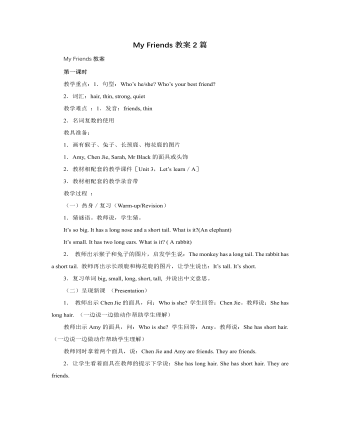
人教版新课标PEP小学英语四年级上册My Friends教案2篇
1.叫一名学生在班里走动,站在一名学生的后面。 2.教师举起一张本单元的单词图片。先正确地说出这个单词第一个字母的读音的学生坐下,另一名学生继续在班里走动,继续活动。 板书设计 :My friends 黑板上方:上课前打好的四线三格,在课堂上随讲随写的字母Ww, Xx, Yy, Zz 黑板下方: 教案点评: 本课时主要学习字母Ww, Xx, Yy, Zz及相关单词。因为本课时将结束字母的学习,因此在热身、复习环节,有必要先进行字母Aa-Vv的听写。然后出示字母卡、单词卡让学生认读字母和复习单词。呈现新课环节,教师可将字母教学放到单词中进行。在教学过程 中,教师结合图片或实物逐个进行字母和单词的教学,可辅以字母课件进行教学,便于学生更好的领会和掌握。教师要注意侧重字母的书写教学,使学生养成正确的书写习惯。两个小游戏“Bingo”和“Listen and show”帮助学生在趣味活动中巩固了所学的全部字母。扩展性活动的设计目的在于复习本单元的单词。
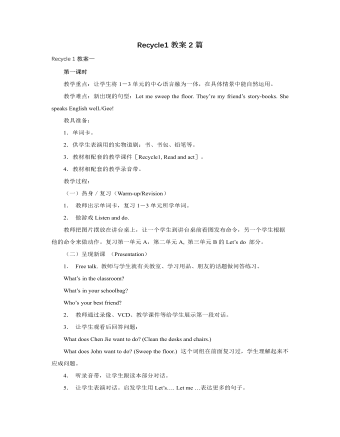
人教版新课标PEP小学英语四年级上册Recycle1教案2篇
Part two1. Teaching AimsMaster the 26 letters.Master the pronunciation of the letters.2. Teaching Aidsa tape-recorder, some cards, some papers and so on.3. Important pointsThe pronunciation of the letters4. Teaching steps1) Greetings and revisionLet some groups act out the dialogue in the last lesson.2) New contentsLet them say out the 26 letters and let some ones say them out.Then listen and learn the letters song.First, give them some minutes and let them read the letters. Let’s see whether there is anyone who can learn anything in them. Then give them some information and let them read again. At last, give them the answer and read again.Let them remember it.PracticeShow the cards where are written the math patterns and let some answer it. Then ask “Who can read it in English?” Let some one read it. Others follow him.Next, show the cards and ask others answer them. T asks and S answers. Then S asks and S answers. Practice in pairs.HomeworkMaster the letters.Teaching notesPart three1. Teaching AimsIntroduce self and others using the words and phrases.Let’s play.2. Teaching Aidsa tape-recorder, some cards3. Important pointsShe has…She likes…I have…4. Teaching stepsGreetings and revisionLet some one read the letters and divide them by the pronunciations.
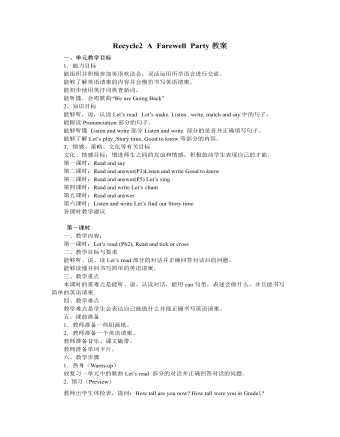
人教版新课标PEP小学英语六年级下册Recycle2 A Farewell Party教案
3. 新课呈现(Presentation) Let’s make (1)教师说:Miss White is making a book about her students. So she can remember them well.Who are the students? 请学生独立或分小组朗读四段短文,解释学生不理解的句子,然后说:There are four pictures below. Would you like to help Miss/White glue the pictures? 教师知道学生完成图文搭配的练习。 (2)教师发给每名学生一张铅画纸,说:Now please draw a picture of your best classmate. Then describe him or her.学生画一副最要好的同学的肖像,并在傍边配上对该同学的英语介绍。 学生上讲台介绍自己最要好的同学,请其他学生猜是谁,看谁说的生动又贴切,教师给予评价时注意强调第三人称单数形式的使用。 Story time 教师向学生展示Story time部分的教学挂图,指着最后一副图中的Zoom 和 Zip说 Look at the picture. Zoom and Zip are sad. They are saying goodbye to each other. Now let’s see What happened. 学生同桌之间合作阅读或是,然后教师提出问题Where is Zip going? Is this good news for zoom ? What grade is Zip going to be in? 教师放录音,学生录音跟读故事,然后再分角色朗读.

北师大初中数学九年级上册营销问题及平均变化率问题与一元二次方程2教案
5.一件上衣原价每件500元,第一次降价后,销售甚慢,第二次大幅度降价的百分率是第一次的2 倍,结果以每件240元的价格迅速出售,求每次降价的百分率是多少?6.水果店花1500元进了一批水果,按50%的利润定价,无人购买.决定打折出售,但仍无人购买,结果又一次打折后才售完.经结算,这批水果共盈利500元.若两次打折相同,每次打了几折?(精确到0.1折)7.某服装厂为学校艺术团生产一批演出服,总成本3000元,售价每套30元.有24名家庭贫困学生免费供应.经核算,这24套演出服的成本正好是原定生产这批演出服的利润.这批演出服共生产了多少套?8、某商店经营T恤衫,已知成批购进时单价是2.5元。根据市场调查,销售量与销售单价满足如下关系:在一段时间内,单价是13.5元时,销售量是500件,而单价每降低1元,就可以多售200件。请你帮助分析,销售单价是多少时 ,可以获利9100元?

北师大初中数学九年级上册几何问题及数字问题与一元二次方程2教案
三、课后自测:1、如图,A、B、C、D为矩形的四个顶点,AB=16cm,BC= 6cm,动点P、 Q分别从点A、C出发,点P以3cm/s的速度向点B移动,一直到达B为止;点Q以2cm/s的速度向点D移动。经过多长时间P、Q两点之间的距离是10cm?2、如图,在Rt △ABC中,AB=BC=12cm,点D从点A开始沿边AB以2cm/s的速度向点B移动,移 动过程中始终保持DE∥BC,DF∥AC,问点D出发几秒后四边形DFCE的面积为20cm2?3、如图所示,人民海关缉私巡逻艇在东海海域执行巡逻任务时,发现在其所处的位置 O点的正北方向10海里外的A点有一涉嫌走私船只正以24海里/时的速度向正东方向航行,为迅速实施检查,巡逻艇调整好航向,以26海里/时的速度追赶。在涉嫌船只不改变航向和航速的前提下,问需要几小时才 能追上( 点B为追上时的位置)?
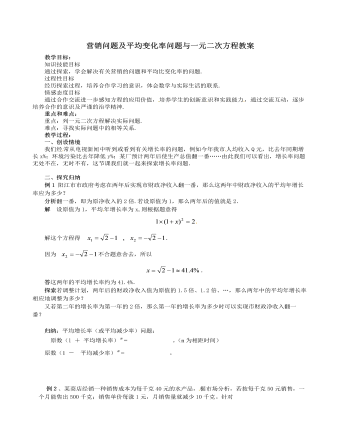
北师大初中数学九年级上册营销问题及平均变化率问题与一元二次方程2教案
5.一件上衣原价每件500元,第一次降价后,销售甚慢,第二次大幅度降价的百分率是第一次的2 倍,结果以每件240元的价格迅速出售,求每次降价的百分率是多少?6.水果店花1500元进了一批水果,按50%的利润定价,无人购买.决定打折出售,但仍无人购买,结果又一次打折后才售完.经结算,这批水果共盈利500元.若两次打折相同,每次打了几折?(精确到0.1折)7.某服装厂为学校艺术团生产一批演出服,总成本3000元,售价每套30元.有24名家庭贫困学生免费供应.经核算,这24套演出服的成本正好是原定生产这批演出服的利润.这批演出服共生产了多少套?8、某商店经营T恤衫,已知成批购进时单价是2.5元。根据市场调查,销售量与销售单价满足如下关系:在一段时间内,单价是13.5元时,销售量是500件,而单价每降低1元,就可以多售200件。请你帮助分析,销售单价是多少时 ,可以获利9100元?
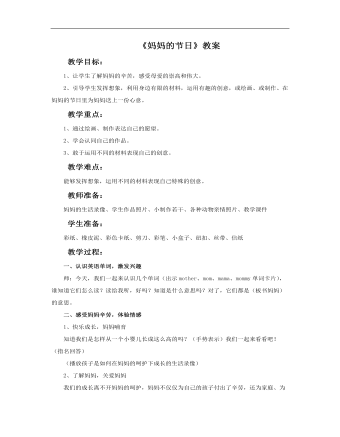
小学美术人教版一年级下册《第12课妈妈的节日》教案
教学重点:1、通过绘画、制作表达自己的愿望。2、学会认同自己的作品。3、敢于运用不同的材料表现自己的创意。教学难点:能够发挥想象,运用不同的材料表现自己特殊的创意。教师准备:妈妈的生活录像、学生作品照片、小制作若干、各种动物亲情照片、教学课件学生准备:彩纸、橡皮泥、彩色卡纸、剪刀、彩笔、小盒子、纽扣、丝带、信纸
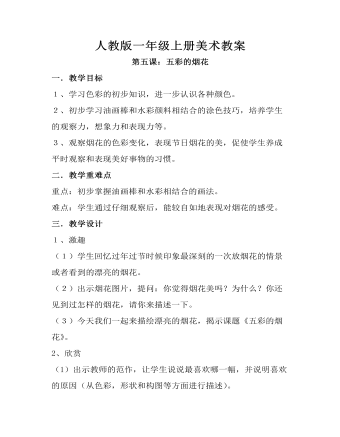
小学美术人教版一年级上册《第5课五彩的烟花》教案
二.教学重难点重点:初步掌握油画棒和水彩相结合的画法。难点:学生通过仔细观察后,能较自如地表现对烟花的感受。三.教学设计1、激趣(1)学生回忆过年过节时候印象最深刻的一次放烟花的情景或者看到的漂亮的烟花。(2)出示烟花图片,提问:你觉得烟花美吗?为什么?你还见到过怎样的烟花,请你来描述一下。(3)今天我们一起来描绘漂亮的烟花,揭示课题《五彩的烟花》。
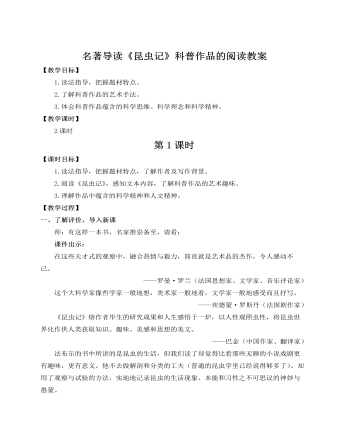
人教部编版语文八年级上册名著导读《昆虫记》 科普作品的阅读教案
整个的螳螂巢,大概可以分成三个部分。其中的一部分是由一种小片做成的,并且排列成双行,前后相互覆盖着,就好像屋顶上的瓦片一样。这种小片的边沿,有两行缺口,是用来做门路的。在小螳螂孵化的时候,就是从这个地方跑出来的。至于其他部分的墙壁,全都是不能穿过的。螳螂的卵在巢穴里面堆积成好几层。其中每一层,卵的头都是向着门口的。前面我已经提到过了,那道门有两行,分成左、右两边。所以,在这些幼虫中,有一半是从左边的门出来的,其余的则从右边的门出来。阅读感悟:作者介绍螳螂的巢时不仅对它们用的材料进行了说明,还对这两种材料做了进一步分析,而且对整个巢的构造做了详细的说明。这些正好体现出作者观察仔细、认真,乐于探究的精神。(2)法布尔科学实验的方法。综合上面两个片段,法布尔在研究昆虫时,经常采用的是观察法和实验法。课件出示:观察法可以直接用肉眼,也可以借助放大镜、显微镜等仪器,或利用照相机、录像机、摄像机等工具,有时还需要测量。
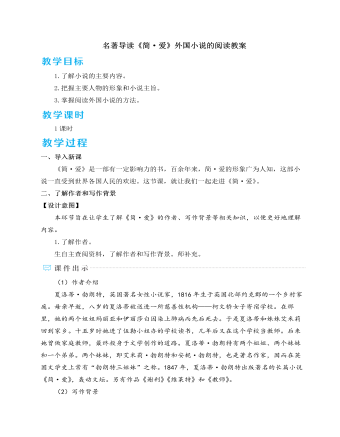
人教部编版语文九年级下册名著导读《简·爱》外国小说的阅读教案
预设 简·爱是一个坚强朴实、刚柔并济、独立自主、积极进取的女性。她出身卑微,相貌平凡,但并不以此自卑。她蔑视权贵的骄横,嘲笑他们的愚笨,显示出自立自强的人格和美好的理想追求。她有顽强的生命力,从不向命运低头,最后有了自己所向往的美好生活。简·爱对自己的思想和人格有着理性的认识,对自己的幸福和情感有着坚定的追求。在她身上,体现了新女性的特点:自尊、自重、自立、自强。六、探究小说的主题思想【设计意图】在理解小说内容和人物形象的基础上,进一步探究小说的主题思想。小组讨论,《简·爱》的主题思想是什么?请简要分析。预设 《简·爱》阐释了这样一个主题:人的价值=尊严+爱。小说中简·爱的人生追求有两个基本“旋律”:富于激情、幻想和反抗精神;追求超越个人幸福的至高境界。这部小说通过叙述一个孤女坎坷不幸的人生经历,成功塑造了一个不安于现状、不甘于受辱、敢于抗争的女性形象,反映了一个小写的人要成为一个大写的人的渴望。
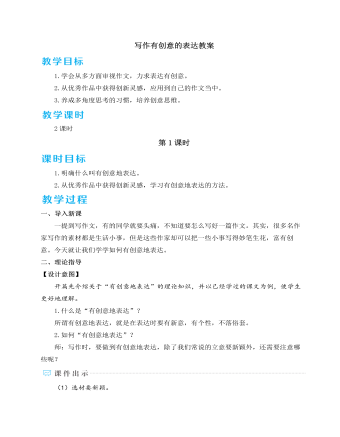
人教部编版语文九年级下册写作有创意的表达教案
1.题目具有开放性,可以实写,也可以虚写。展开联想和想象,将自己想到的全列出来,然后再从中确定写作重点。2.从题目看,可以灵活选择文体。比如,可以以写景或抒情为主,也可以进行议论,或者虚构一个故事等,要力求有创意。3.注意表达上的创新,丰富的词语、恰当的修辞等,都可以为文章增色。2.写作指导。(1)审题立意。本题具有开放性,有实虚两重意义。展开联想和想象,可以写实,也可以写它的象征意义,还可以实虚结合。“春天的色彩”既可以指现实中的春天的各种色彩,也可以指象征意义中的“春天”带着“色彩”(以表达某种心情)。如自然的春天、社会的春天、心灵的春天等等。(2)文体选择与表达。在文体方面,可以写成写景或抒情的散文,也可以写议论文,或者写成表达“春天的色彩”这一主题的记叙文。在表达上应有创新,可以用丰富的词汇、变换的句式、新颖的修辞为文章增色。尤其在作文形式上要有所创新。
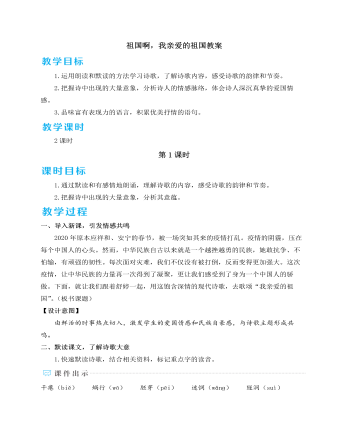
人教部编版语文九年级下册祖国啊,我亲爱的祖国教案
诗歌创作个性十足,难以用统一的规律去分析,然而发掘一些欣赏诗歌的一般性的思路和角度,可以让阅读诗歌有章可循,减少学生读诗时的畏难情绪。在第1课时中,我以朗读为贯穿课堂的抓手,让学生通过思考“怎么读”,自觉地去发现并分析诗歌中的意象,理解诗歌大意,让学生对诗歌有初步的理解和体会。第2课时在整体把握诗歌的基础上,具体去分析诗歌中富有表现力的语言,训练学生深入思考的能力,引导学生梳理诗歌的情感脉络,体会诗中作者的情感变化,理解诗人想要表达的真挚情感,并通过拓展阅读让学生尝试自己解读诗歌,帮助学生巩固所学的阅读诗歌的方法。两节课的侧重点不同,但都围绕这首诗的特点和整体教学思路进行规划,做到“一课一得”。写作背景舒婷初中毕业后下乡插队,后又当过工人。在国家蒙难、人民遭殃的非常岁月,备尝艰辛的舒婷,内心的迷惘、痛苦可想而知。1978年12月,中国迎来了具有重大历史意义的十一届三中全会,开启了改革开放的历史新时期。1979年4月,诗人面对祖国摆脱苦难、正欲奋飞的情景,以自己独有的抒情方式写下了此诗。

小学美术人教版一年级上册《第6课美丽的印纹》教案
3.让学生讨论并说说除了手之外,还可以用什么东西来印。三、布置作业1.团结协作;2.注意卫生;3.比一比,哪一组印得最美丽。

人教部编版语文八年级下册写作说明的顺序教案
片段三:大殿正中是一个约两米高的朱漆方台,上面安放着金漆雕龙宝座,背后是雕龙屏。方台两旁有六根高大的蟠龙金柱,每根大柱上盘绕着矫健的金龙。仰望殿顶,中央藻井有一条巨大的雕金蟠龙。从龙口里垂下一颗银白色大圆珠,周围环绕着六颗小珠,龙头、宝珠正对着下面的宝座。梁枋间彩画绚丽,有双龙戏珠、单龙翔舞,有行龙、升龙、降龙,多态多姿,龙身周围还衬托着流云火焰。——黄传惕《故宫博物院》 (1)找出三个片段中关于说明顺序的标志性词语。预设 片段一:立春过后、再过两个月、不久、于是转入、到了秋天、准备迎接。片段二:首先、此外、还可以、也可以。片段三:正中、上面、背后、两旁、殿顶、中央、周围、下面、周围。(2)学生归纳结论。预设 正确使用标志性的词语,能使对说明对象及内容的介绍更清楚。(3)小组讨论:以时间、空间或逻辑为序的说明语段,通常使用哪些标志性的词语?预设 时间顺序的说明语段一般要运用表示时间或先后的标志性词语;空间顺序的说明语段要运用表示方位的词语,如“东、西、南、北、里、外、左、右”等;逻辑顺序的说明语段可使用“首先”“其次”“再次”等表示由主到次的词语。






